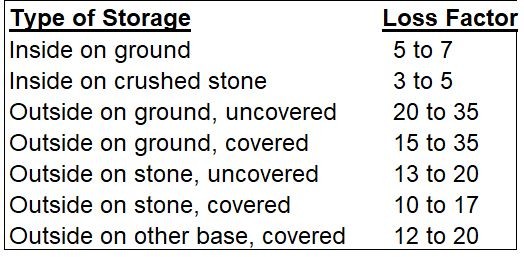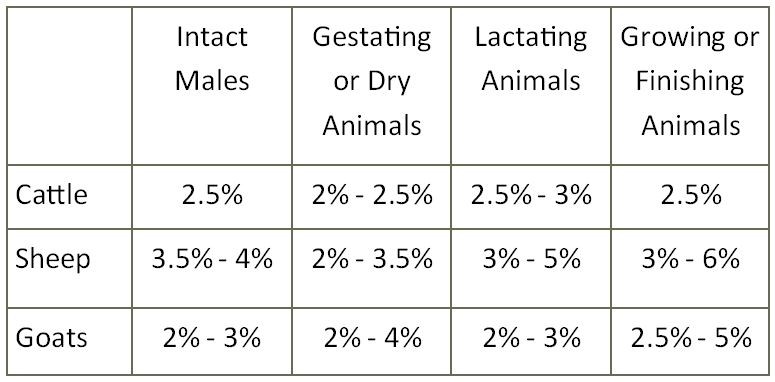Determining Forage Inventories with Pen and Paper
Amy Barkley, Team Leader & Livestock Specialist
Southwest New York Dairy, Livestock and Field Crops Program
This year has been a bit of a rocky one for livestock farmers across SWNY concerning their forage harvests. Wet hayfields were impossible to move equipment over in the early part of the season, and first cutting was lower quality for many farmers who missed the ideal harvest window. Shortly after, hot, dry weather set in, stunting cool season forage growth. Many livestock farmers reported smaller than average subsequent cuttings, if they got any at all. It goes without saying that stored forage inventories across the region are lower than usual this year, and so before the cold weather sets in, it's time to calculate how much hay and baleage you have and see if it's enough to meet the needs of your sheep, goats, and cattle over the winter. Buying in hay this time of year to fill in any production loss will be much easier than trying to source it when it's February and you realize that you're going to run short. And, selling animals this time of year if you know you're going to run short of hay may be a smart move for your operation.
To calculate forage inventories is simple, and to do so, you'll need the following information:
· Number of bales
· Average weight of bales
· Dry Matter of bales (baleage is between 45%-60% dry matter, hay should be around 15% dry matter)
· Anticipated storage loss (see table 1) and feeding loss
· Number of animals on the farm and approximate weights
· Anticipated consumption of animals (see table 2)
· The number of days you anticipate having to feed this winter (6 months is a good place to start)
To calculate the amount of forage you have available:
- You'll first need to multiply the average weight of your bales by the number of bales you have. As an example, let's say that we have 500 small squares of dry hay that weigh 40 pounds each. That would be 20,000 pounds of hay on an as-fed basis.
- After the total weight of forage available is calculated, calculate the percentage of that forage that is dry matter. For example, if we know that the moisture of our dry hay is 12%, that means that the dry matter value will be calculated by taking the difference of 100% dry matter and 12% dry matter, which is 88%. Then, we will take that percentage as a decimal (.88 in this example), and multiply it by the weight of forage we have on an as-fed basis. For our example, that would be .88 x 20,000 = 17,600 pounds of dry matter available.
- The anticipated loss is determined from the sum of the loss expected during storage plus the anticipated feeding loss. The table below will help you estimate loss associated with storage. Feeding loss is based on experience. While storage loss estimates are pretty standard, feeding loss comes from factors including the feeder type, feeding area, and species. This number is unique to your farm. For our example, let's say that our hay is stored in the attic of a barn (0% loss) and our animals tend to waste 10%. Our loss factor is 0% + 10% = 10%, which means that our animals consume 90% of the forage we put up. The loss factor is then multiplied by the amount of dry matter available to get an estimate of the pounds of dry matter our animals have available to consume this winter. In our example, that's .9 x 17,600 = 15,840 pounds of feed available.
 Table 1. This loss table is based on unwrapped haybales. Wrapped bales will have little to no loss. This table was created by Bill Halfman, University of Wisconsin. Click to enlarge.
Table 1. This loss table is based on unwrapped haybales. Wrapped bales will have little to no loss. This table was created by Bill Halfman, University of Wisconsin. Click to enlarge.The next step in the calculation process is to determine how much feed your animals will consume over the course of a day:
- First, list the number of animals you have and their production groups. For my example, I have 20 ewes that weigh 120 pounds each and 1 ram and 1 wether that weigh 150 pounds each. The example doesn't use lambs because in this hypothetical, they were lambed in the late winter, put out to pasture at weaning, and sold before winter. Idealistic, I know (:
- Next, determine the consumption of your livestock. The table below, complied from NRC (National Research Council) recommendations, gives general estimates of the consumption of the major grazing species classes as the % of bodyweight per day. Our example ewes are gestating, and because they have a tendency to carry twins and triplets, and because they will be nursing while on stored feed, their feed needs will fall on the higher end of gestating and lactating range for sheep. Also note that animals tend to consume a larger volume of higher quality forage vs lower quality forage because lower quality forage stays in the gut longer, making them feel full... even if it's less nutritious. In this example, our hay is of moderate quality. That, plus the gestating considerations having me go with 4% here as % of dry matter intake per animal.
- Multiply the number of animals in each group by their individual weight and then by their anticipated consumption as a percent of bodyweight. Then, add those consumption values of the groups together to get your daily consumption. Our example flock has a group of 20 ewes x 120 pounds bodyweight x .04 = 96 pounds of dry matter for the ewes/day. The wether and ram are 300 total pounds x 0.035 = 10.5 pounds of feed for the males. That means that all the sheep on the farm are anticipated to consume 106.5 pounds of dry matter feed per day.
 Table 2. Nutrient values for the three major grazing species by production category. The values are derived from NRC recommendations. Generally, animals in the later part of gestation will require more nutrients or a higher volume of feed to meet their energy and protein needs. The same goes for animals that are expected to gain at a high rate vs a moderate or slow rate. Lactating animals with multiples require more feed than lactating animals with singles. Animals will eat more of a higher quality forage than of a lower quality forage. Click to enlarge.
Table 2. Nutrient values for the three major grazing species by production category. The values are derived from NRC recommendations. Generally, animals in the later part of gestation will require more nutrients or a higher volume of feed to meet their energy and protein needs. The same goes for animals that are expected to gain at a high rate vs a moderate or slow rate. Lactating animals with multiples require more feed than lactating animals with singles. Animals will eat more of a higher quality forage than of a lower quality forage. Click to enlarge.
Finally, calculate how much feed they will consume this winter and compare that number to the amount of forage you have available.
- I generally recommend that producers estimate for a late pasture green-up and an early move off pastures in the fall since we know that mother nature can be fickle. At this point, you can even estimate a set number of days for summer feeding if you find that your pastures normally enter a summer slump and/or calculate a set number of extra days in the case of drought. In our example, we're going to pretend that we have a nice mix of cool season pastures, silvopasture, and summer annuals, so we won't need to calculate for summer feed. The grazing season on our imaginary hilltop starts around May 20th, and ends around November 1st, since we stockpile. That gives us 200 days for the grazing season, or 165 days for the winter feeding season.
- Multiply the number of days on stored feed by the pounds you anticipate the animals to consume per day. Our little flock will consume 106.5 pounds of dry matter/day x 165 days = 17,572 pounds of dry matter will be needed this winter.
- Compare the results of your calculation to the amount of stored feed you have, and see how close you are! In our example, we have 15,840 pounds of dry matter available, and need 17,572 pounds of dry matter. That's really close, but if I had to choose in this example, I would pick up one more ton of forage just to be on the safe side. Sometimes, the amount of forage you need will be more than what you have, meaning you need to buy in forage or sell off animals. Other times, there is a large calculated excess of stored feed, which means you can keep it for insurance or sell some. This decision comes from your experience and comfort with risk.
As you're going through this series of calculations, and you're unsure where you fall in terms of moisture, loss, or animal weights, estimate on the higher ends for moisture, loss, and animal weights. This will make your calculation more conservative. It's better to have hay left over at the end of the year than it is to need to scramble at the last minute to secure feed. With the days moving towards crisp and cool, I highly recommend running these numbers as soon as you can if you haven't already.
If you need any assistance or have any questions, feel free to reach out to Amy Barkley at amb544@cornell.edu or 716-640-0844.
Upcoming Events
Crops, Cows & Critters - Southwest New York Dairy, Livestock & Field Crops Newsletter Sponsorship
December 19, 2025
January 30, 2026
Our two forms of publications feature research-based and timely information from our four specialists, listed to the right, along with local event notifications and Cornell University outreach. This information is provided to participants who range from dairy, livestock, and field crops producers to agricultural suppliers and consultants.
Weekly Email Update: Shared with 625+ households who have signed up with our program.
Monthly Paper Mailer: To reach our stakeholders and farmers who lack internet access, we send out a monthly mailer where your company's logo and contact information would be featured with a mailing list of 330+ households.
If you sponsor our weekly and monthly publications you reach approximately 955 households.
Visit our website to view our newsletters!
2025 Cornell Food Beverage & Animal Feed Manufacturer Survey
December 19, 2025
Industry and Educational Advocates for New York State's Food, Beverage, and Animal Feed Manufacturing industries:
As you know, NYS has a diverse food and beverage manufacturing industry, in both the types of industries that exist and the wide distribution of firms by scale. Many manufacturing firms have strong backward linkages to agricultural production sectors in the state that support both farm-level and downstream food industry firms and consumers. In collaboration with the New York State Department of Agriculture and Markets, a team from Cornell University's Charles H. Dyson School of Applied Economics and Management has recently rolled out the 2025 New York State Food, Beverage, and Animal Feed Manufacturer Survey. The industry will benefit from an updated assessment of the industry that informs private and public investments and opportunities to support firm growth and improved profitability.
Boots in the Barn: Cornell Dairy Research Updates
January 13, 2026
January 20, 2026
January 27, 2026
February 3, 2026
February 10, 2026
February 17, 2026
February 24, 2026
Join us for some or all!
Announcements
No announcements at this time.





